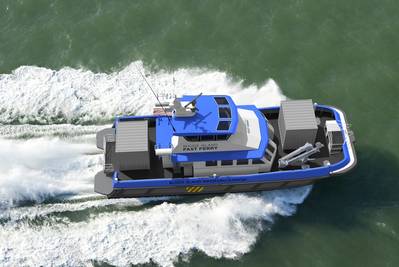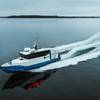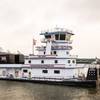US Builder Secures Wind Farm Supply Vessel Order
Rhode Island based shipbuilder Blount Boats signed a contract with Rhode Island Fast Ferry for the construction of a crew transfer vessel (CTV) that will operate for Deepwater Wind Block Island, the shipbuilder announced today.
The 21-meter aluminum vessel was designed by South Boats IOW (Isle of Wight), a company that has designed and built approximately 85 CTVs for the European Offshore Wind Sector. In 2011, Blount Boats signed a licensing agreement with South Boats to become the exclusive shipyard to manufacture U.S. Flagged aluminum catamarans of South Boats IOW designs for the U.S. wind farm industry.
The stock twin hulled, all aluminum catamaran will be dual certified to USCG Subchapter T (Small Passenger) to carry up to 49 passengers and subchapter L (Offshore Supply Vessel) to carry up to 16 offshore workers.
The propulsion system consists of two MAN V12-1,400 horsepowerp engines, ZF Marine 3050 Gears, and Hamilton Jet HM571 waterjets. The vessel is predicted to reach sprint speeds in excess of 28 knots, with the ability to cruise (80 percent power) at 27 knots when in a light condition and 23 knots in loaded condition.
A Cummins Onan 17 kilowatt generator will provide AC power to the air conditioning system, a heating system and small galley. A PTO driven hydraulic system will power a deck crane, the fire pump, a fuel transfer pump, and a salt water pressure washing system. All other equipment will be fed DC power through house batteries.
The vessel is designed to carry up to 12 tons of cargo in the bow and 3 tons of cargo in the stern. The forward and after decks are outfitted with cargo lashing and container sockets. A knuckleboom crane will be outfitted onto the bow area.
The bow has a bow boarding/loading platform to allow offshore workers to make the transition from the vessel to the wind turbine. The vessel connects to the turbine base by use of a special bow fendering system. The specified fender is the latest generation in proven fendering systems being installed in the European fleet. The vessel will be capable of making transfers in 1.5-meter significant wave heights.
The interior of the deckhouse will be outfit with a head, a small galley area with settee seating, twelve suspension seats, storage lockers, entertainment system, Wi-Fi, and sound absorbing decking. The entire deck house is isolated from the hull with vibration mounts for a quieter and smoother ride to and from the work site.
Delivery is scheduled for April 1, 2016, with the vessel entering service by May of that year.












